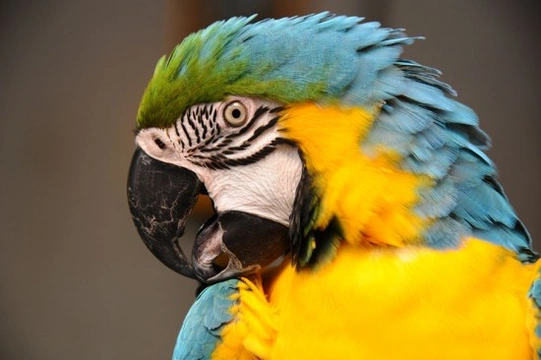
Keeping birds - Common conditions of the feathers and skin
Whilst all bird keepers hope that their feathered friend will thrive and stay healthy for the duration of their often long lives, there's no getting away from the fact that problems with the skin and/ or feathers can affect a lot of birds at some point, for a variety of reasons.Here are eight of the most common skin and feather problems to look out for in your pet bird.
Parasitic Mites
Parasitic mite infestation is perhaps the most common of all skin and feather conditions which birds both wild and tame are apt to suffer from. Mites generally infest the top surfaces of the skin, leading to rough areas and shedding or flaking of the skin cells. Mites can, however, spread to the cere (a waxy structure covering the base of the beak) which can eventually lead to potential damage and malformation of the beak.The two types of mites that pet birds are most prone to, are knemidokoptes and myialges. Knemidokoptes are most commonly found in budgies, but they are not unique to this species. Knemidokoptes do not cause itching in most species of birds, but cause a type of avian mange which is known as 'scaly face' or 'scaly' leg, depending on the affected area(s.) A bird infected with knemidokoptes may not show any signs of ill health for an extended time after infection, as the condition can remain latent for long periods without presenting any symptoms. Eventually, lesions which have a wart- like appearance will begin to appear around the beak, legs and other un-feathered areas.If the infection affects the legs, the claws become overgrown and can show cracks, and the legs become scaly and rough. In advanced cases of infection, the bird will have difficulty perching and eventually become unable to perch at all.Treatment consists of the application of a veterinary prescribed insecticide, and management of any secondary infection or associated problems.In contrast, myialges cause extreme irritation and itching to your bird's skin, and left untreated, leads to feather loss, weight loss, red inflamed skin and eventual death.As with knemidokoptes, a veterinary insecticide such as Ivermectin will be prescribed to treat the cause of the infestation.Veterinary diagnosis by means of skin scrapings and microscopic evaluation is required to confirm the presence of either knemidokoptes or myialges mites in your bird.
Feather picking and plucking
Seeing your bird picking at or plucking out their own feathers can be very distressing for the caring owner to witness. While feather plucking can generally be explained by stress and behavioural factors, it is important to investigate any possible clinical causes for the behaviour, such as mites, injury, or skin conditions first.
Polyfolliculitis
The word 'poly' means 'many,' and polyfolliculitis or polyfollicle growth is a condition where more than one feather grows out of one skin follicle. There is some debate over the root cause of polyfolliculitis, although it is most widely thought to be caused by the presence of a viral infection. The most commonly affected areas of the bird are the tail and the neck, although the condition can be found on any feathered parts of the body. In some birds, polyfolliculitis causes no discomfort or problems, while in others it may cause inflammation and irritation of the affected feathers and the surrounding skin. Both budgies and lovebirds are particularly prone to an itchy form of polyfolliculitis.
Baldness
Baldness on the head area only, as opposed to a more widespread loss of feathers due to illness or feather plucking, is most commonly found in canaries, but as with most conditions, can also affect other species. Both hormonal imbalances and genetic or hereditary causes are thought to be responsible for localised baldness of the head area.
Brown Hypertrophy
Hypertrophy means the enlargement of an organ or tissue at a cellular level. In cases of brown hypertrophy, the cere of the beak, containing the bird's nostrils, becomes keratinised (hardened) and develops a brownish proliferation of horn-like tissue and cornification.While the condition is most commonly found in female birds and is related to the hormonal changes brought about by breeding, it is also found in male birds as a result of oestrogen producing tumours.Brown hypertrophy is most commonly found in budgies.
Cysts of the Feathers
Feather cysts can be found on any feathered area of the bird, although they are most usually noticed around the wings. The cysts present as swellings which can affect either individual feather follicles, or small groups. Cysts develop in the same manner as ingrown hairs do on people, where the developing feather does not grown up from the skin in the usual manner and instead grows within the follicle and curls over. As the ingrown feather develops, the cyst will begin to secrete a smelly discharge.Feather cysts can either be caused by a genetic predisposition (often found in canaries and some species of macaws) or they can develop as the result of an injury or infection of the follicle.When treating feather cysts, the entire affected follicle is usually removed, as just removing the malformed feather usually leads to recurrence.
Xanthomas
Xanthomas are fatty tumours that lie beneath the skin, leading to pitted patches of skin with a yellow or orange appearance. It is thought that xanthomas are caused by feeding a diet too high in fat. The thighs, breast and tips of the wings are the most commonly affected areas. Some affected birds will respond well to nutritional changes, while others may require surgical intervention.
Stress Bars
Stress bars are found on the feathers, and present as lightly coloured lines running across the width of the feather shaft. Owners will most often notice stress bars on the shed feathers when the bird is moulting.In order to reduce and eventually eliminate stress bars on new feather growth, you will need to evaluate your bird's diet and living environment and possibly seek expert advice on potential triggers and causes.



